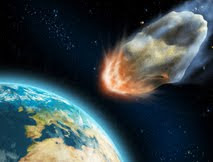
An international team of scientists studying remnants of an asteroid that crashed into the Nubian Desert in October 2008 discovered it contained at least 10 different types of meteorites. Some of them contained chemicals that form the building blocks of life on Earth, and those chemicals were spread through all parts of the asteroid by collisions. Chemists at Stanford University found that different meteorite types share the same distinct fingerprint of polycyclic aromatic hydrocarbons (PAHs). These complex organic molecules are distributed throughout the galaxy and form on Earth from incomplete combustion.
A research team from NASA's Goddard Space Flight Center in Greenbelt, Md., found amino acids in strongly heated fragments of the asteroid, where all such molecules should have been destroyed. Both PAHs and amino acids are considered building blocks of life. Before landing on Earth, the 13-foot asteroid was detected by a telescope from the NASA-sponsored Catalina Sky Survey based at the University of Arizona in Tucson. Hours prior to its demise, astronomers and scientists around the world tracked and scanned the asteroid. It was the first time a celestial object was observed prior to entering Earth's atmosphere.
NASA's Jet Propulsion Laboratory in Pasadena, Calif., created a search grid and impact target area. The data helped Peter Jenniskens, an astronomer at NASA's Ames Research Center in Moffett Field, Calif., and the SETI Institute of Mountain View, Calif., guide a recovery team from the University of Khartoum in Sudan to search the desert landscape. During four expeditions, approximately 150 students recovered nearly 600 meteorite fragments weighing a total of more than 23 pounds. "Right from the start, the students were surprised to find so much diversity in meteorite texture and hue," said Muawia Shaddad, an astronomer at the University of Khartoum, who led the search effort. "We estimate the asteroid initially weighed about 59 tons, of which about 86 pounds survived the explosion high in the atmosphere."
A research team from NASA's Goddard Space Flight Center in Greenbelt, Md., found amino acids in strongly heated fragments of the asteroid, where all such molecules should have been destroyed. Both PAHs and amino acids are considered building blocks of life. Before landing on Earth, the 13-foot asteroid was detected by a telescope from the NASA-sponsored Catalina Sky Survey based at the University of Arizona in Tucson. Hours prior to its demise, astronomers and scientists around the world tracked and scanned the asteroid. It was the first time a celestial object was observed prior to entering Earth's atmosphere.
NASA's Jet Propulsion Laboratory in Pasadena, Calif., created a search grid and impact target area. The data helped Peter Jenniskens, an astronomer at NASA's Ames Research Center in Moffett Field, Calif., and the SETI Institute of Mountain View, Calif., guide a recovery team from the University of Khartoum in Sudan to search the desert landscape. During four expeditions, approximately 150 students recovered nearly 600 meteorite fragments weighing a total of more than 23 pounds. "Right from the start, the students were surprised to find so much diversity in meteorite texture and hue," said Muawia Shaddad, an astronomer at the University of Khartoum, who led the search effort. "We estimate the asteroid initially weighed about 59 tons, of which about 86 pounds survived the explosion high in the atmosphere."
No comments:
Post a Comment